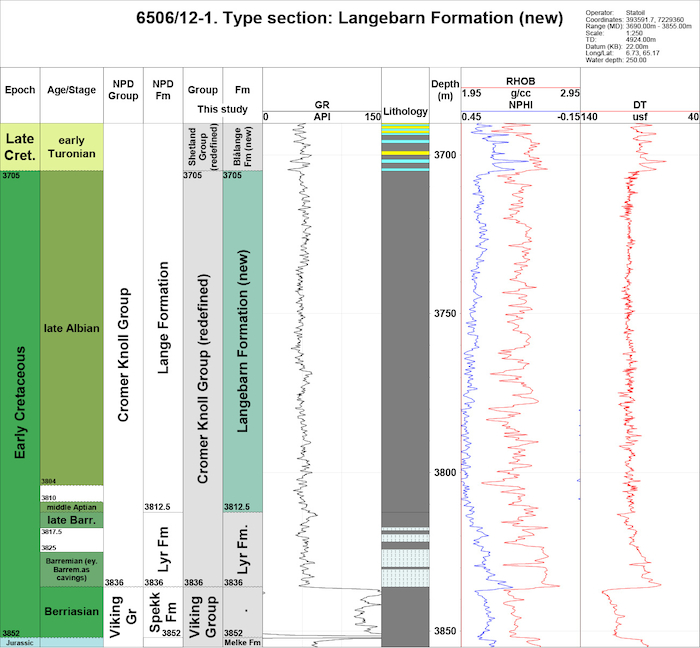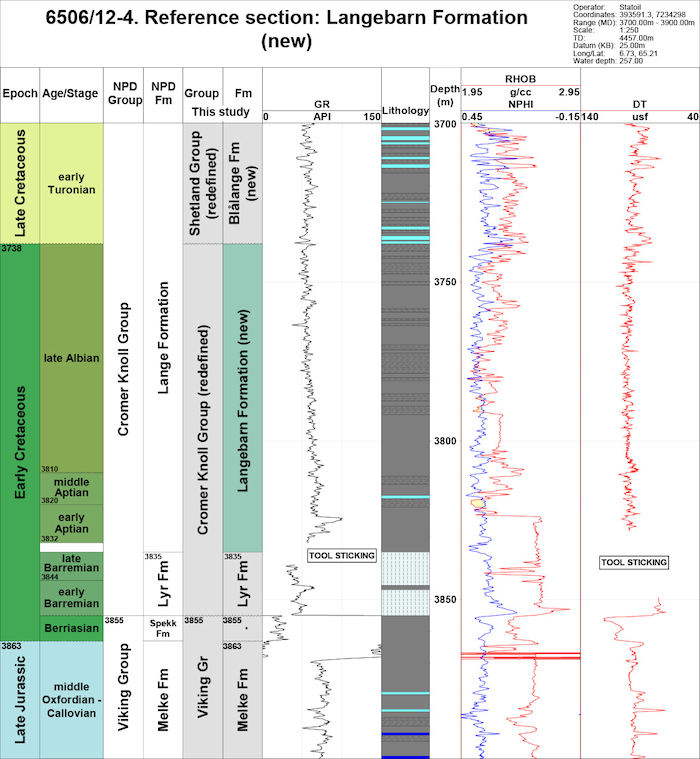 |
|
 |
|
updated to follow: Stratigraphic Guide to the Cromer Knoll, Shetland and Chalk Groups of the North Sea and Norwegian Sea. Felix M. Gradstein & Colin C. Waters (editors), Mike Charnock, Dirk Munsterman, Michelle Hollerbach, Harald Brunstad, Øyvind Hammer & Luis Vergara (contributors). Newsletter on Stratigraphy, vol 49/1 pp71-280, 2016
Cromer Knoll Group
The Langebarn Formation is a new formation representing the lower part of the original Lange Formation of Dalland et al. (1988). It represents a relatively uniform sequence of Lower Cretaceous (Albian-Aptian) marine mudstones with sporadic limestone stringers. The upper part of the original Lange Formation is defined as a new formation also, the Blålange Formation. In the type area of the Halten Terrace, the Langebarn and Blålange Formations are separated by a significant stratigraphic break that corresponds to the Lower/Upper Cretaceous boundary. With this new definition, it is now practical to redefine the Cromer Knoll Group in the Norwegian Sea with a similar stratigraphic extent to that in the North Sea. The Langebarn Formation being time-equivalent to the Rødby and Sola Formations in the North Sea area.
Sandstones within the redefined Lange Formation are generally rare, although a sandstone unit is discussed informally that was penetrated in well 6507/7-12. This unit was informally described as 'Aptian Sands' by the Operator in a Lower Cretaceous mini-basin drilled in the hanging wall of the Revfallet Fault complex separating the Dønna Terrace from the Nordland Ridge/Trøndelags Platform. Thus, sandstones may be developed in this formation in the deeper, undrilled parts of the Vøring Basin.
Derivatio nominis: The name Langebarn is derived from the Norwegian for the fish species Lumpenus lumpretaeformis, or more correctly, the Langhalet Langebarn or Snakeblenny. This fish is found along the entire Norwegian coast and is usually associated with muddy bottoms at 30-200 m water depths.
The Langebarn Formation consists predominantly of mudstones containing occasional stringers of limestone and rare sandstones. The mudstones are similar to those of the overlying Blålange Formation, but are generally more uniform with fewer limestone and sandstone interbeds. The mudstones are light to medium grey, grey brown, occasionally green-brown, soft, plastic, amorphous, non- to moderately calcareous, blocky, firm, locally subfissile, micromicaceous and slightly silty in part.
An informal sandstone unit in the well 6507/7-12 (3670-3703.5 mMD and 33.5 m thickness) consists of sandstones and interbedded siltstones and mudstones. Sandstones are medium grey to dark grey in colour, white to light yellowish grey, clear quartz grains, very fine to coarse, predominantly fine to medium, becoming very silty, grading to siltstone, subangular to subrounded, occasionally angular in coarse fraction, moderately sorted, friable, argillaceous matrix, common silica cement or locally moderate calcareous cement, locally trace of coal, mica and pyrite, rare glauconite, no visible porosity.
The siltstones are dark grey, blocky, firm, slightly calcareous, argillaceous grading to mudstones in part, locally very fine sandy, grading to silty sandstones, carbonaceous.
The mudstones are grey, black to olive black, blocky, sub-fissile, moderately hard to hard, non calcareous becoming locally very silty, carbonaceous to very carbonaceous.
The Langebarn Formation ranges in thickness from 3 m to 467 m.
The (new) Langebarn Formation is generally regionally extensive, and is only absent from parts of the Nordland Ridge and on local highs along the western flank of the Trøndelag Platform. However it has generally not been penetrated in the deep wells of the Vøring Basin, so data from this area is lacking. It reaches a maximum thickness of 467 m in well 6507/7-12. This well was drilled in an Early Cretaceous mini basin, developed in the hanging wall of the Revfallet Fault complex separating the Dønna Terrace from the Nordland Ridge to the east, and contains rare interbedded sandstones and mudstones (informal unit).
The formation is generally thicker in wells on the Dønna Terrace e.g. 6507/2-3 (432 m). Elsewhere, on the Halten Terrace it is generally between 50-150 m thick although it may reach 300 m in some wells, e.g. 6406/3-2. In the Helgeland Basin, it locally reaches over 150 m, e.g. in well 6610/7-1.
Reference well 6506/12-4: 11 slides from dc samples covering the interval 3757 m - 3835 m (Stratlab and RRI preparations) deposited at the Norwegian Petroleum Directorate.
WGS84 coordinates: N 65°10'07.58, E 06°43'44.07
UTM coordinates: 7229359.52 N 393591.68 E
UTM zone: 32
Drilling operator name: Den norske stats oljeselskap a.s. (Statoil
a.s.)
Completion date: 06.02.1985
Status: P & A
Interval of type section & thickness in type well:
3812.5 m - 3705 m, 107.5m thickness.
The lower boundary follows the original definition of Dalland et al. (1988). Previously, the
original Lange
Formation extended from 3190 m. The interval 3705 m to 3190 m is now assigned as the new formation:
Blålange Formation.
 Type well 6506/12-1 (click to enlarge) |
Well name: 6506/12-4
WGS84 coordinates: N 65°12'46.97, E 06°43'30.37
UTM coordinates: 7234298.14 N 393591.29 E
UTM zone: 32
Drilling operator name: Den norske stats oljeselskap a.s. (Statoil
a.s.)
Completion date: 13.08.1985
Status: P & A
Interval of type section & thickness in reference well:
3835 m to 3738 m, 97 m thickness. The lower boundary follows the
original definition for the Lange Formation of Dalland et al.
(1988). The upper boundary of the Langebarn Formation is with the
new Blålange Formation.
It is unfortunate that Dalland et al. (1988) defined the 6506/12-4
as the reference section for the Lange Formation as the base of the formation
with the underlying Lyr Formation has an incomplete
log profile (on both
gamma ray and sonic logs) due to the tool sticking during wireline logging
(see figure).
 Reference well 6506/12-4 (click to enlarge) |
In the type area of the Halten and Dønna Terraces, the boundary between the Langebarn Formation and overlying Blålange Formation is characterised by a down-section decrease in sonic velocities representing a stratigraphic break corresponding to the Lower/Upper Cretaceous boundary.
The base of the Langebarn Formation is typically with the underlying Lyr Formation and is characterised by an increase in gamma-ray values and decrease in velocity. The boundary has been sampled in shallow cores from the eastern part of the Trøndelag Platform (Bugge et al., 1984).
In the type well 6506/12-1 the Langebarn Formation is middle Aptian to late Albian in age, and has unconformable lower and upper boundaries with the Lyr and Blålange Formations respectively. In the type well the lower boundary of the Langebarn Formation lies between the LO Gardodinium trabeculosum, LO Cerbia tabulata and LO Aptea polymorpha dinocyst markers and downhole increase in Hedbergella spp. defining a middle Aptian age, and above the LO Valensiella magma typical of late Barremian.
In the type well, sediments of early Aptian age are absent at the base of the formation. In other wells, including the reference well 6506/12-4, the lower boundary with the underlying Lyr Formation is complete and a thin early Aptian interval characterised by LO Sirmiodinium grossii is developed at the base of the Langebarn Formation.
In the type and reference wells, the upper boundary with that of the overlying Blålange Formation is associated with the late Albian dinocyst LO Apteodinium grande and the planktonic foraminiferal event LAO Hedbergella planispira. In these wells Cenomanian sediments of the basal Blålange Formation are absent.
In the 6507/7-12 well, an informal unit of interbedded sandstones and mudstones developed between 3670-3703.5 m MD and informally referred to as 'Aptian Sands' by Conoco (operator) is dated between the LO Achmosphaera neptuni (3600 m) of middle Aptian age and LO Sirmodinium grossii (3750 m) of early Aptian age, establishing firmly that the member is middle Aptian in age.
Early Cretaceous, early Aptian to late Albian. Dalland et al. (1988) had the oldest extent of their Lange Formation as ranging into the Ryazanian Boreal stage, and as a partial time equivalent of the Lyr Formation which they considered to be Valanginian to early Aptian. This interpretation is not followed in this study with the oldest extent of the Langebarn Formation being stratigraphically younger than the Lyr Formation.
The Langebarn Formation represents deposition with the K2 sequence of Swieciki et al. (1998), K35 to K40 sequences of Vergara et al. (2001), and the K20 - K30 sequences of Færseth and Lien (2002). It is noteworthy that Lower Cretaceous sandstones of the Langebarn and Lyr Formations do not represent any appreciable thickness and are exceptionally rare in the Norwegian Sea based on the available released well coverage. This may be due to the Lower Cretaceous interval being generally not reached in wells drilled in the Vøring Basin. In addition, the wells drilled at the margins of the Trøndelags Platform are typically on structurally high Cretaceous locations in the quest for deeper lying Jurassic prospects. The frequency and distribution of Lower Cretaceous sandstones analogous to the North Sea Agat Member is therefore considered to be underestimated, based on the available well data. The (informally retained) sandstones penetrated in well 6507/7-12 represent the best example drilled to date of these potentially more extensive Lower Cretaceous sandstones.
Dalland, A., Worsley, D. and Ofstad, K. 1988. A lithostratigraphic scheme for the Mesozoic and Cenozoic succession offshore Mid and Northern Norway. Bulletin of the Norwegian Petroleum Directorate, Bulletin No. 4, 1-65.
Færseth, R. and Lien, T. 2002. Cretaceous evolution in the Norwegian Sea - a period characterized by tectonic quiescence. Marine and Petroleum Geology, 19, 1005 -1027.
Gradstein, F., Kaminski, M.A. and Agterberg, F.P. 1999. Biostratigraphy and paleoceanography of the Cretaceous seaway between Norway and Greenland. Earth-Science Reviews, 46, 27-98.
Swiecicki, T., Gibbs, P.B., Farrow, G.E. and Coward, M.P. 1998. A tectonostratigraphic framework for the Mid-Norway region. Marine and Petroleum Geology, 15, 245-276.
Vergara, L., Wreglesworth, I., Trayfoot, M., Richardsen, G. 2001. The distribution of Cretaceous and
Paleocene deep-water reservoirs in the Norwegian Sea basins. Petroleum Geoscience, 7, 395-408.
| home | previous page |